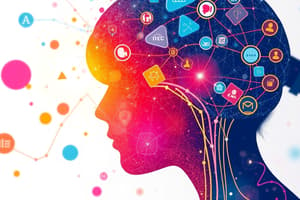Podcast
Questions and Answers
What is the false consensus effect primarily characterized by?
What is the false consensus effect primarily characterized by?
- Being indifferent to the beliefs and attitudes of others.
- Underestimating the similarities in beliefs among peers.
- Using personal beliefs as a standard to assess others' beliefs. (correct)
- Correctly identifying the behaviors of others based on accurate data.
What is most likely to be a result of impression management?
What is most likely to be a result of impression management?
- Distortion of self-image to fit social expectations. (correct)
- Muscle memory in social interactions.
- Honest reflection of one's capabilities.
- Authenticity in self-presentation.
What type of attribution is often used when individuals evaluate their own failures?
What type of attribution is often used when individuals evaluate their own failures?
- Self-serving bias
- Dispositional attribution
- Fundamental attribution
- Situational attribution (correct)
Which of the following best describes the self-serving bias?
Which of the following best describes the self-serving bias?
What is a core feature of self-serving attribution?
What is a core feature of self-serving attribution?
Which scenario best illustrates the fundamental attribution error?
Which scenario best illustrates the fundamental attribution error?
What is the primary function of schemas in social psychology?
What is the primary function of schemas in social psychology?
In the context of attribution theory, how do people typically explain others' negative outcomes?
In the context of attribution theory, how do people typically explain others' negative outcomes?
Which concept states that people are likely to interpret their experiences positively?
Which concept states that people are likely to interpret their experiences positively?
How does the motivation to think positively about oneself influence perception?
How does the motivation to think positively about oneself influence perception?
Which concept describes the tendency to view a new person through the lens of past experiences with someone similar?
Which concept describes the tendency to view a new person through the lens of past experiences with someone similar?
Which of the following illustrates the fundamental attribution error?
Which of the following illustrates the fundamental attribution error?
What does the attribution process seek to explain?
What does the attribution process seek to explain?
Which of the following statements best defines heuristics?
Which of the following statements best defines heuristics?
Which of the following aligns with impression management techniques?
Which of the following aligns with impression management techniques?
What is a common misconception associated with self-serving bias?
What is a common misconception associated with self-serving bias?
In the context of social perceptions, what are the two dimensions often used to categorize individuals?
In the context of social perceptions, what are the two dimensions often used to categorize individuals?
The tendency to perceive oneself favorably compared to others is known as what?
The tendency to perceive oneself favorably compared to others is known as what?
What is the fundamental attribution error?
What is the fundamental attribution error?
Which of the following describes a situation where impression management might occur?
Which of the following describes a situation where impression management might occur?
What is an example of a schema?
What is an example of a schema?
Which term best describes the tendency to explain another's behavior with internal factors rather than considering external context?
Which term best describes the tendency to explain another's behavior with internal factors rather than considering external context?
What impact does making accurate impressions of others have on social interactions?
What impact does making accurate impressions of others have on social interactions?
Which of the following would NOT typically be a focus of attribution?
Which of the following would NOT typically be a focus of attribution?
Which bias refers to the tendency to attribute personal success to internal factors and failures to external circumstances?
Which bias refers to the tendency to attribute personal success to internal factors and failures to external circumstances?
What is a common result of the fundamental attribution error in social interactions?
What is a common result of the fundamental attribution error in social interactions?
In social psychology, what role does the fusiform face area play in interpersonal interactions?
In social psychology, what role does the fusiform face area play in interpersonal interactions?
Which of the following accurately describes impression management?
Which of the following accurately describes impression management?
How do schemas influence an individual's interpretation of new social information?
How do schemas influence an individual's interpretation of new social information?
Flashcards are hidden until you start studying
Study Notes
False Consensus
- Individuals tend to overestimate the extent to which others share their beliefs and attitudes.
- Example: College students overestimate the prevalence of alcohol and drug use among peers.
Impression Management
- Individuals attempt to present a favorable image of themselves when interacting with others.
Attribution
- The process of assigning causal explanations to events, actions, or outcomes.
- Attributions can be internal (attributing the cause to personal factors) or external (attributing the cause to situational factors).
- Example: If your mom didn't make dinner when you arrived home, you might attribute it to her disliking you (internal) or being busy (external).
Self-Serving Attribution
- Tendency to attribute successes to internal factors and failures to external factors.
Fundamental Attribution Error
- The tendency to overemphasize internal factors (personality traits) and underestimate situational factors when explaining others' behavior.
Motivation to Think Positively
- Individuals are motivated to maintain a positive self-image.
- This motivation can bias perceptions and beliefs.
Self-Serving Attitudes
- Attributions individuals make regarding their own behavior and outcomes are often self-serving.
Social Psychology
- Social psychology studies how social contexts and broader cultural environments influence people's thoughts, feelings and actions.
- It focuses on how the immediate environment influences behaviour.
- Social psychology looks at how people act differently across various situations.
- Accurate impressions of people can improve interactions, as it allows for better prediction of their actions, feelings and words.
- The Fusiform Face Area of the brain is responsible for Facial Recognition.
- Schemas: mental representations that organize associated pieces of information about a person.
- There are two dimensions to categorizing people: friend or foe, and their status or competence.
- Heuristics: mental shortcuts used to make quick evaluations.
- Transference: treating a new person as if they possess traits or characteristics of a familiar person.
Attributions
- People tend to make dispositional attributions for positive things and situational attributions for negative things.
- This leads to a broader bias of interpreting experiences in a positive light.
- People tend to overestimate the influence of factors that are relevant or irrelevant to them.
- For example, when people are unhappy in a new location, they overemphasize the features of the place, rather than factors that bring joy, such as family and friends.
Attitudes
- Attitudes involve an affective feeling towards a target, a cognitive belief about the target's characteristics, and a behavioral motivation to approach or avoid that target.
- Attitudes can be weak predictors of behavior, especially when they are abstract.
- Implicit attitudes: automatically activated evaluations that range from positive to negative towards target stimuli. They are believed to be rooted in evolutionary survival instincts.
- Explicit attitudes: conscious evaluations of target stimuli.
Persuasion
- Persuasion involves changing held attitudes by directly appealing to them.
- Persuasive techniques include appealing to people's emotions, attractiveness, and credibility.
- There are two routes to persuasion: the central route, which focuses on the strength of the argument, and the peripheral route, which relies on superficial cues.
- The central route uses evidence, expert reviews and statistics.
- The peripheral route uses surface-level reasoning and automatic associations.
Compliance Strategies
- Compliance strategies change behavior without targeting attitudes towards a product, idea or message.
Cognitive Dissonance
- People strive for understanding the world around them, and their own thoughts and actions.
- Cognitive dissonance is a conflict between actions and attitudes that motivates efforts to reduce dissonance and restore internal consistency.
- One experiences cognitive dissonance by behaving out of line with their beliefs, values or attitudes.
- Cognitive dissonance can trigger attitude change.
- People need a rationale to intentionally conflict their actions with their attitudes about something.
- For example, people who had to lie for 1toexperiencecognitivedissonance,comparedtothosewholiedfor1 to experience cognitive dissonance, compared to those who lied for 1toexperiencecognitivedissonance,comparedtothosewholiedfor20, which did not need another rationale for the behavior.
- Post-decision dissonance: discomfort with having chosen one desirable option over another.
- Effort justification: valuing something more because of how difficult it was to obtain.
Social Norms and Conformity
- Social norms: patterns of behavior, traditions, beliefs and preferences that are accepted and reinforced by others and influence behavior.
- Conformity: internalizing, mimicking and adopting the behavior of others around you.
- Conformity can satisfy the need to belong and fit in. It allows us to adapt to broader cultures and get along with others.
- Informational social influence involves conforming to the actions or beliefs of others to behave correctly or to gain an accurate understanding of the world.
- Normative social influence involves conforming to gain approval or avoid disapproval from others.
Social Facilitation and Social Loafing
- Being around others or feeling a sense of social connection can boost motivation.
- Social facilitation: the presence of others can boost arousal, which facilitates the dominant response or most likely behavioral reaction to a task.
- Easy tasks see a boost in productivity when performed in front of others; difficult tasks make errors more likely due to the dominant response.
- Social loafing: individuals expend less effort on a task when working with others, compared to working alone.
- Social loafing is more likely to occur if individual performance is unnoticed by others.
Group Polarization and Groupthink
- Group polarization: people's attitudes on an issue become more extreme after discussion with like-minded others.
- Group polarization justifies extreme decision making.
- Polarized groups rely on a limited range of facts.
- Polarized groups are overconfident about their decisions.
- Groupthink: avoiding unpopular opinions to maintain group consensus. Groupthink is exacerbated by dominant group leaders.
Leadership and Obedience
- Leaders rise to power by demonstrating skills or showing dominance to intimidate others into following.
- Milgram's experiment: 65% of participants complied with the experimenter, despite predictions that only 0.01% would.
- People are more likely to obey authority figures when the victim is out of sight and the authority figure is present.
Aggression
- Aggression: any behavior directed towards harming another living being.
- The General Aggression Model: predicts the likelihood of aggressive behavior.
- Negative situational effects (frustrating events, insults, aversive cues) can prompt aggression.
- Threats to belonging and acceptance can trigger aggression.
- Aggression is influenced by proximity to the goal (closer to the goal = more aggression/further away = less aggression).
- Aggression can be situational.
- The weapons effect: exposure to weapons can increase aggressive responses by bringing violent thoughts to mind.
Altruism
- Kin selection: assisting those who share one's genes, even at personal cost, to increase the odds of genetic survival. Helping those genetically related to you.
- Norm of reciprocity: adaptive advantage to helping strangers, as people who are helped are likely to help back.
- This norm exists because it helps societies succeed.
- Empathy is key to altruism: putting oneself in another person's shoes and feeling their emotions.
- Empathy gap: inability to accurately simulate the emotions of another person.
The Bystander Effect
- Bystander effect: people are less likely to help a victim in an emergency when others are present, compared to when they are alone.
- This is because the presence of other bystanders makes the situation feel less like an emergency.
- Pluralistic ignorance: people are collectively unaware of each other's true attitudes or beliefs.
- Diffusion of responsibility: individuals assume someone else has already helped or would be more skilled at helping.
- To overcome the bystander effect, people need to: (1) recognize the situation as an emergency and (2) take personal responsibility for helping.
Stereotypes and Prejudice
- Stereotypes: mental representations or schemas about groups.
- Stereotypes are often used to judge individual members of that group.
- They are energy-saving devices and are often used when people are tired.
- They can help justify the way things are.
- Prejudice: a negative attitude toward a group or its members.
- Prejudice leads to discrimination.
- People naturally carve up their social world into social groups.
- Discrimination: the differential treatment or outcomes an individual receives due to their membership in a particular social group.
- Realistic group conflict theory: negative intergroup attitudes develop when groups compete for scarce resources.
- Social identity theory: people maintain positive attitudes towards their ingroup by seeing other groups/outgroups in a more negative light.
- Symbolic racism: prejudice directed towards racial/ethnic groups, specifically towards policies created to benefit them.
- For example, being opposed to affirmative action programs by claiming they are unfair to those who earn it through merit.
Implicit and Explicit Racial Biases
- Implicit racial biases: differential treatment as a response to the inability to control negative attitudes and stereotypes towards a racial group.
- Explicit racial biases: result from negative attitudes and stereotypes that are openly endorsed and freely expressed.
- Aversive racism: a tendency, even among egalitarian individuals, to subconsciously have negative thoughts about someone who belongs to a racial/ethnic group.
Contact Hypothesis
- Contact hypothesis: prejudice can be reduced through cooperative interactions between members of different groups, working towards a common goal.
- The Robbers Cave experiment (Sherif): two groups of boys were separated, competed, and then worked together. Cooperation led to mutual understanding and befriending.
Relationships
- Humans are social creatures.
- Relationships are formed through exposure and familiarity.
- Physical proximity or frequent close contact is a requirement for a relationship.
- Mere exposure leads to familiarity and liking.
- Attitudes, interests, and background experiences shape relationship formation.
- People tend to befriend those from similar socioeconomic, racial/ethnic, political, and religious backgrounds.
- Chameleon effect: mimicking another person's mannerisms, accent, and speech patterns.
Attraction
- Attraction is often driven by what is different from ourselves.
- The "Exotic Becomes Erotic" phenomenon plays a part.
- Evolutionary perspective: people are attracted to healthy mates who have the best chance of genetic transmission. Physical cues to health signal attractiveness.
- Parental investment theory: explains sex differences in attraction due to the time, risk and effort invested during procreation.
- Straight men report higher interest in young, physically attractive women, while straight women are more attracted to men who are financially well off.
- Across 37 cultures, people prioritize positive personality traits (kindness, sense of humor) for long-term relationships.
Relationship Problems
- Defensiveness: denial of personal responsibilities.
- Stonewalling: refusal to continue conversation.
- Contempt: dismissiveness of the other person's point of view.
- Criticism: using personal attacks during arguments.
Attachment Styles
- Attachment theory: explains the importance of secure bonds between infants and their primary caregivers.
- Secure attachment: feeling worthy of love, viewing others as trustworthy. Leads to successful and lasting relationships.
- Anxious-ambivalent attachment: prone to jealousy and anger, but passionate in relationships.
- Dismissive-avoidant attachment: self-confident, but reluctant to become close or dependent on a partner.
- Fearful-avoidant attachment: negative self-view and mistrust of others.
- Placing emphasis on a partner's positive attributes, instead of downplaying their weaknesses, promotes lasting relationships.
- Triangular theory of love: passion, intimacy, and commitment.
- Consummate love combines all three components.
Online Interactions
- Online interactions enable easier connections with friends and family who live far away.
- Large social networks (even online) are associated with lower stress and higher well-being.
- Sharing negative thoughts and feelings online can lower self-esteem and be off-putting to other users.
Studying That Suits You
Use AI to generate personalized quizzes and flashcards to suit your learning preferences.




